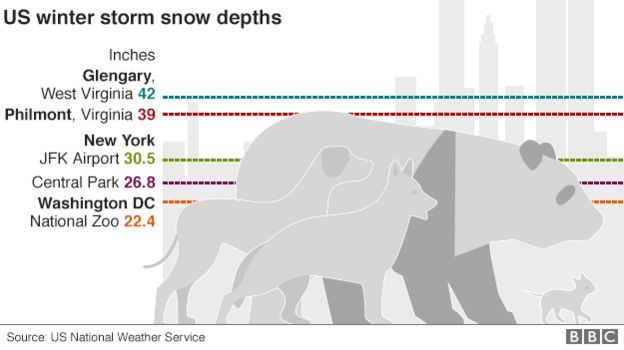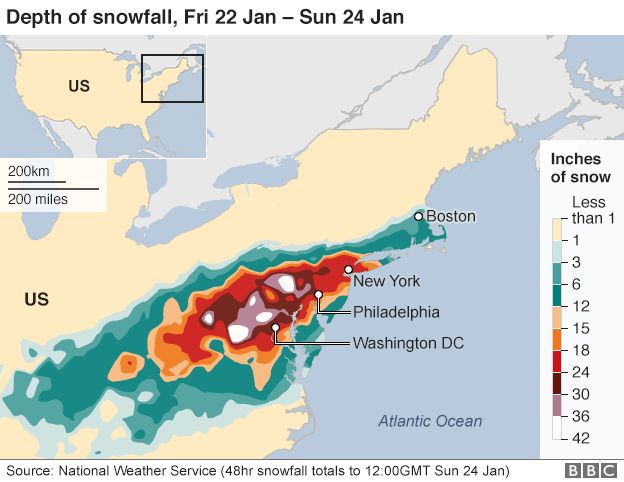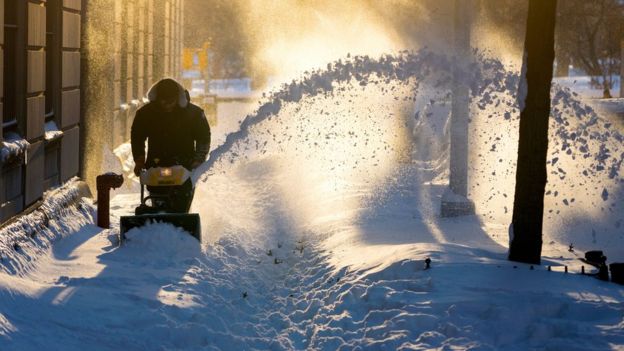Post by The Big Daddy C-Master on Jan 25, 2016 6:48:42 GMT -5
www.bbc.com/news/world-us-canada-35394742
Millions of people across the eastern US face huge challenges with the working week set to begin, following a massive snowstorm that virtually paralysed many cities.
Public transport will be patchy, many roads are still treacherous and airports remain severely disrupted.
Government buildings in Washington and many schools will be closed on Monday.
Near record snowfall swept from the capital to New York, with at least 29 deaths reported since Friday.
The fatalities were as a result of car accidents, carbon monoxide poisoning and heart attacks suffered while shovelling snow.
'Snowmageddon'
Many East Coast residents spent Sunday digging out their cars and clearing pathways of snow which reached about 3ft (91cm) in five states.
Why do so many people die shovelling snow?
17 pictures that sum up the snowstorm
How New Yorkers avoided going stir crazy
The storm, dubbed "Snowmageddon" and "Snowzilla", has now weakened and headed out into the Atlantic Ocean.
It affected some 85 million people, at one point cutting the power to 300,000 people. The heaviest fall was recorded in Glengary, West Virginia, which had 42in.

In New York City - which saw its second-highest snowfall since records began in 1869 - a travel ban that effectively shut the city down now been lifted.
New York's Metropolitan Transportation Authority has said that almost all public transport services will be running in time for the morning rush hour.
All New York City schools will open, the New York Times said in its update on services.
New York City Mayor Bill de Blasio urged people to leave their cars covered with snow all week, but he tweeted that the city was now "bouncing back".

Other areas were faring less well.
In Washington DC, less used to dealing with heavy snow, an "extremely limited" metro, rail and bus service is due to run and residents have been warned to expect delays. Officials said fares would not be charged.
Federal government offices and public schools in the US capital will remain shut throughout the day. Many schools all the way up to New Jersey will also be closed.
State employees in Virginia and Maryland were told to stay home on Monday.
Carbon monoxide fatalities
An elderly couple are killed after their garage door slams shut in Greenville, South Carolina, trapping them inside with a generator
A mother and one-year-old child in Passaic, New Jersey, are killed as they sit inside their car for warmth while her husband tries to dig it free of snow. The exhaust was blocked
A driver in Pennsylvania trying to move his car has it engulfed in snow by a passing plough and he is trapped inside
Nearly 12,000 flights had to be cancelled over the weekend.
Hundreds more will be cancelled on Monday, although airports in New York City, Baltimore, and Philadelphia have limited services.
Why was there so much snow?

Elements often come together to create snow, but not always in the same way and to this extent - it was the "perfect" winter storm
A low pressure system was able to transport and circulate huge amounts of moisture north from the Gulf of Mexico
The position of the jet stream allowed a low pressure system to be picked up and drawn northwards along the eastern seaboard
Very warm air falling into very cold air from the north and mixing meant there was only one thing that would happen - snow
Very strong winds: low pressure moves in one direction and high pressure in another and, much like cogs in a wheel, they increased the wind
The storm moved especially slowly
By the time the snow had stopped falling after two days, late on Saturday, New York's Central Park had received 26.8in, the second-biggest fall recorded since 1869.
The total was just 0.1in (0.25cm) shy of the all-time high, 26.9in, recorded in February 2006.
However, the 26.6in that fell in the park on Saturday alone was a one-day record for the city.
Emergencies were declared in 11 states and in the District of Columbia.
Parts of New Jersey and Delaware also reported coastal flooding.

Millions of people across the eastern US face huge challenges with the working week set to begin, following a massive snowstorm that virtually paralysed many cities.
Public transport will be patchy, many roads are still treacherous and airports remain severely disrupted.
Government buildings in Washington and many schools will be closed on Monday.
Near record snowfall swept from the capital to New York, with at least 29 deaths reported since Friday.
The fatalities were as a result of car accidents, carbon monoxide poisoning and heart attacks suffered while shovelling snow.
'Snowmageddon'
Many East Coast residents spent Sunday digging out their cars and clearing pathways of snow which reached about 3ft (91cm) in five states.
Why do so many people die shovelling snow?
17 pictures that sum up the snowstorm
How New Yorkers avoided going stir crazy
The storm, dubbed "Snowmageddon" and "Snowzilla", has now weakened and headed out into the Atlantic Ocean.
It affected some 85 million people, at one point cutting the power to 300,000 people. The heaviest fall was recorded in Glengary, West Virginia, which had 42in.

In New York City - which saw its second-highest snowfall since records began in 1869 - a travel ban that effectively shut the city down now been lifted.
New York's Metropolitan Transportation Authority has said that almost all public transport services will be running in time for the morning rush hour.
All New York City schools will open, the New York Times said in its update on services.
New York City Mayor Bill de Blasio urged people to leave their cars covered with snow all week, but he tweeted that the city was now "bouncing back".

Other areas were faring less well.
In Washington DC, less used to dealing with heavy snow, an "extremely limited" metro, rail and bus service is due to run and residents have been warned to expect delays. Officials said fares would not be charged.
Federal government offices and public schools in the US capital will remain shut throughout the day. Many schools all the way up to New Jersey will also be closed.
State employees in Virginia and Maryland were told to stay home on Monday.
Carbon monoxide fatalities
An elderly couple are killed after their garage door slams shut in Greenville, South Carolina, trapping them inside with a generator
A mother and one-year-old child in Passaic, New Jersey, are killed as they sit inside their car for warmth while her husband tries to dig it free of snow. The exhaust was blocked
A driver in Pennsylvania trying to move his car has it engulfed in snow by a passing plough and he is trapped inside
Nearly 12,000 flights had to be cancelled over the weekend.
Hundreds more will be cancelled on Monday, although airports in New York City, Baltimore, and Philadelphia have limited services.
Why was there so much snow?

Elements often come together to create snow, but not always in the same way and to this extent - it was the "perfect" winter storm
A low pressure system was able to transport and circulate huge amounts of moisture north from the Gulf of Mexico
The position of the jet stream allowed a low pressure system to be picked up and drawn northwards along the eastern seaboard
Very warm air falling into very cold air from the north and mixing meant there was only one thing that would happen - snow
Very strong winds: low pressure moves in one direction and high pressure in another and, much like cogs in a wheel, they increased the wind
The storm moved especially slowly
By the time the snow had stopped falling after two days, late on Saturday, New York's Central Park had received 26.8in, the second-biggest fall recorded since 1869.
The total was just 0.1in (0.25cm) shy of the all-time high, 26.9in, recorded in February 2006.
However, the 26.6in that fell in the park on Saturday alone was a one-day record for the city.
Emergencies were declared in 11 states and in the District of Columbia.
Parts of New Jersey and Delaware also reported coastal flooding.



